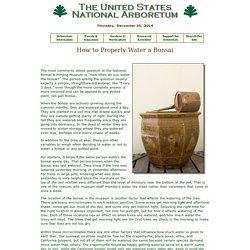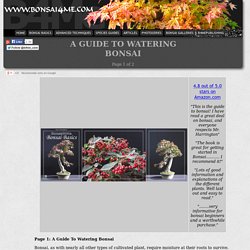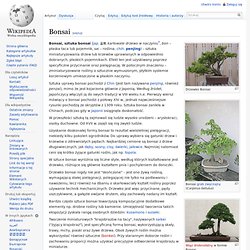

The Bonsai Primer: Watering. Watering your Bonsai By far the most e-mail I get concerns watering.

There are may instances where someone has purchased a Bonsai from a non specialist supplier, and been told to "water it every few days", this is wrong. You must use your judgement to ensure the tree gets enough water for its needs and if this means watering it two or three times a day at the height of summer, or indeed not watering it for a month or so during the winter, then do so. Of the things your bonsai need to survive, water is going to prove to be the most difficult to provide in the right quantities at the right times.
Too little water and your tree will shed leaves or needles, then branches in an effort to stay alive. Ideally the soil should be moist at all times and be moist all the way through. You should try to have a large container full of rainwater, filling your watering can from this, as most tap water now has chemicals added. How to properly water a bonsai. The most commonly asked question at the National Bonsai & Penjing Museum is “How often do you water the bonsai?”

The person asking the question usually expects a simple, straightforward answer, like “Every 3 days,” even though the more complete answer is more involved and can be applied to any potted plant, not just bonsai. When the bonsai are actively growing during the summer months, they are watered about once a day. They are planted in a soil mix that drains quickly and they are outside getting plenty of light. During the fall they are watered less frequently since they are going into dormancy. In the dead of winter they are moved to winter storage where they are watered even less, perhaps once every couple of weeks. Bonsai Care - How to Water a Bonsai Tree - The Helpful Gardener. Gardening tips: The Helpful Gardener brings the pleasure of gardening to your home.

You will find our Bonsai articles collected in one spot. Check back often because we are constantly adding new bonsai tips and articles. This is the crux of the art of bonsai. Most trees that die (I prefer the phrase “permanent dormancy”) are lost to dehydration, either from lack of watering or from being kept in a low humidity environment (indoors) too long. Different soils dry at different rates, trees differ from species to species in water requirements and even different styles of pots dry out at varying rates, so each pot must be checked regularly until you become more familiar with the plant in question.
How to water bonsai. A GUIDE TO WATERING BONSAI. Page 1: A Guide To Watering Bonsai Bonsai, as with nearly all other types of cultivated plant, require moisture at their roots to survive.

Without a continual source of moisture, the tree is unable to continue its life process, initially losing leaves, then branches and finally the entire tree can die. Never doubt that the quickest way of killing a bonsai is to allow the compost to dry out completely. However, though the effects of under-watering are immediate, over-watering a bonsai also causes ill-health in trees. The effects of continual over-watering takes much longer to become noticeable and can often be difficult to diagnose. In the confines of a pot, a bonsai loses this ability to self-regulate its exposure to moisture. Plants rely on a continual flow of water to stay alive and to grow.
As previously mentioned, the effects of over-watering a far more subtle and can take a relatively long period of time to detect. More worryingly, the dead roots start to rot. Bonsai. Bonsai. Bonsai sites. Japanese interests. Bonsai.org.pl - strona o sztuce bonsai. Akademia Bonsai - WWW.BONSAI.PL. Bonsai. Drzewko Bonsai Bonsai, sztuka bonsai (jap.

盆栽, karłowate drzewo w naczyniu? , bon – płaska taca lub pojemnik, sai – roślina; chiń. penjing) – sztuka miniaturyzowania drzew lub krzewów uprawianych w odpowiednio dobranych, płaskich pojemnikach. Efekt ten jest uzyskiwany poprzez specyficzne przycinanie oraz pielęgnację. W potocznym znaczeniu – zminiaturyzowane rośliny o sztucznie wymuszonym, płytkim systemie korzeniowym umieszczone w płaskim naczyniu. Sztuka uprawy bonsai pochodzi z Chin (jest tam nazywana penjing, również penzai), mimo że jest kojarzona głównie z Japonią. W przeszłości sztuką tą zajmowali się ludzie wysoko urodzeni – arystokraci, osoby duchowne. W sztuce bonsai wyróżnia się liczne style, według których kształtowane jest drzewko, różniące się głównie kształtem pnia i pochyleniem do doniczki.